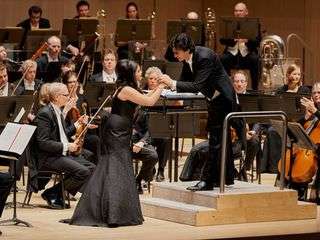|
Back
An evening of subtleties Toronto
Roy Thomson Hall
11/12/2015 - & November 14, 2015
Richard Strauss: Salome, opus 54: "Dance of the Seven Veils"
Antonín Dvorák: Rusalka, opus 114: "Song to the Moon"
Gustave Charpentier: Louise: "Depuis le jour"
Gustav Mahler: Symphony No. 4 in G Major
Simone Osborne (soprano)
The Toronto Symphony Orchestra, Michael Sanderling (conductor)

S. Osborne & M. Sanderling (© Malcolm Cook)
The TSO’s Decades Project continued with this pair of concert featuring works from 1900-1909, starting with “The Dance of the Seven Veils” from Salome, composed in 1905. The orchestra was augmented to the full 106 players required for the original orchestration, while guest conductor Michael Sanderling (making his local debut) avoided bombast by starting the music on a very slow boil, gradually increasing the heat until the startling climax.
The orchestra resumed its more normal size to accompany lyric soprano Simone Osborne in operatic arias, beginning with the “Song to the Moon” from Rusalka, a work from 1900. The balance between orchestra and singer (which can be problematic with the orchestra on stage instead of in a pit) was fine and the piece was given a nice glow. Ms Osborne gives it s softer edge than one would probably get from a Slavic singer. Another aria from 1900, ”Depuis le jour” from Gustave Charpentier’s Louise was given similar dreamily rapturous treatment.
We were then treated to an encore number, the “Vilja Song” from Franz Lehár’s The Merry Widow, sung in English.
The main work on the program was Gustav Mahler’s Symphony No. 4, completed in 1900 and premiered in 1901. At the start I thought Michael Sanderling was keeping it too quiet - I wanted the sleighbells to jangle more loudly. However as it progressed his insistence on building the piece gradually became totally engrossing. The third movement Ruhevoll (poco adagio) was especially riveting as it built to an intense episode, then swerves angrily and embodies a demented carousel which incongruously leads a sublime transcendental moment. Kevin Bazzana’s notes mention that early audiences found the work “maddeningly incomprehensible”, and perhaps early performances were (except those under Mahler himself, one would hope). Now that the work has had more than a century of performance, a sensitive, well-schooled conductor like Michael Sanderling (whose esteemed father also guest conducted the TSO) can make all the work’s contradictions add up to an organic whole.
Simone Osborne's contribution to the performance was in total accord.
The audience was obviously captured by the performance, and respected the conductor’s gesture for a lengthy silence at the end.
Two additional items from the first decade of the twentieth century will be performed in this series: Sergei Rachmaninoff’s Piano Concerto No. 2 (from 1901) as the sole work on one of Rob Kapilow’s “What Makes it Great?” evenings (with pianist Alexander Seredenko) on November 13, and Ernö Dohnányi’s Serenade in C Major for String Trio, Op. 10 (from 1903) performed by orchestra principals prior to the November 14 performance of this program.
Michael Johnson
|